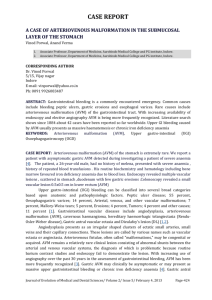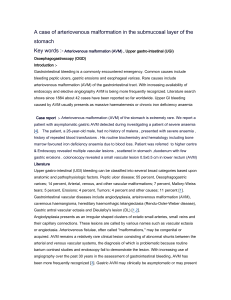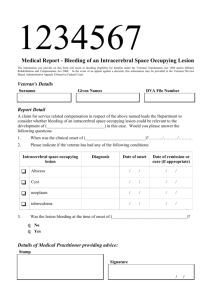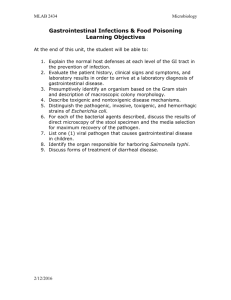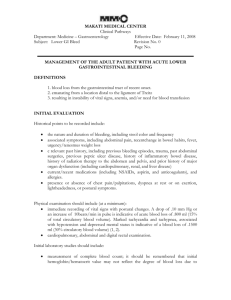Poster Print Size: Change Color Theme: A Rare Cause of Gastrointestinal Bleeding
advertisement
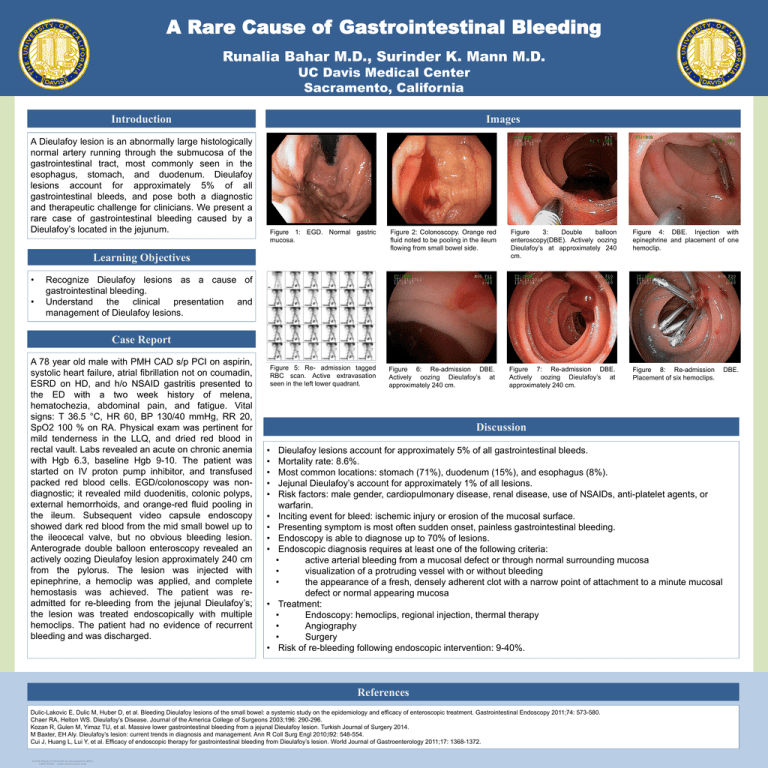
A Rare Cause of Gastrointestinal Bleeding Runalia Bahar M.D., Surinder K. Mann M.D. UC Davis Medical Center Sacramento, California Introduction Images A Dieulafoy lesion is an abnormally large histologically normal artery running through the submucosa of the gastrointestinal tract, most commonly seen in the esophagus, stomach, and duodenum. Dieulafoy lesions account for approximately 5% of all gastrointestinal bleeds, and pose both a diagnostic and therapeutic challenge for clinicians. We present a rare case of gastrointestinal bleeding caused by a Dieulafoy’s located in the jejunum. Figure 1: EGD. Normal gastric mucosa. Figure 2: Colonoscopy. Orange red fluid noted to be pooling in the ileum flowing from small bowel side. Figure 3: Double balloon enteroscopy(DBE). Actively oozing Dieulafoy’s at approximately 240 cm. Figure 4: DBE. Injection with epinephrine and placement of one hemoclip. Figure 5: Re- admission tagged RBC scan. Active extravasation seen in the left lower quadrant. Figure 6: Re-admission DBE. Actively oozing Dieulafoy’s at approximately 240 cm. Figure 7: Re-admission DBE. Actively oozing Dieulafoy’s at approximately 240 cm. Figure 8: Re-admission Placement of six hemoclips. Learning Objectives • • Recognize Dieulafoy lesions as a cause of gastrointestinal bleeding. Understand the clinical presentation and management of Dieulafoy lesions. Case Report A 78 year old male with PMH CAD s/p PCI on aspirin, systolic heart failure, atrial fibrillation not on coumadin, ESRD on HD, and h/o NSAID gastritis presented to the ED with a two week history of melena, hematochezia, abdominal pain, and fatigue. Vital signs: T 36.5 °C, HR 60, BP 130/40 mmHg, RR 20, SpO2 100 % on RA. Physical exam was pertinent for mild tenderness in the LLQ, and dried red blood in rectal vault. Labs revealed an acute on chronic anemia with Hgb 6.3, baseline Hgb 9-10. The patient was started on IV proton pump inhibitor, and transfused packed red blood cells. EGD/colonoscopy was nondiagnostic; it revealed mild duodenitis, colonic polyps, external hemorrhoids, and orange-red fluid pooling in the ileum. Subsequent video capsule endoscopy showed dark red blood from the mid small bowel up to the ileocecal valve, but no obvious bleeding lesion. Anterograde double balloon enteroscopy revealed an actively oozing Dieulafoy lesion approximately 240 cm from the pylorus. The lesion was injected with epinephrine, a hemoclip was applied, and complete hemostasis was achieved. The patient was readmitted for re-bleeding from the jejunal Dieulafoy’s; the lesion was treated endoscopically with multiple hemoclips. The patient had no evidence of recurrent bleeding and was discharged. Figure 1. Label in 28pt Calibri. Figure 2. Label in 28pt Calibri. Discussion • • • • • • • • • • • Dieulafoy lesions account for approximately 5% of all gastrointestinal bleeds. Mortality rate: 8.6%. Most common locations: stomach (71%), duodenum (15%), and esophagus (8%). Jejunal Dieulafoy’s account for approximately 1% of all lesions. Risk factors: male gender, cardiopulmonary disease, renal disease, use of NSAIDs, anti-platelet agents, or warfarin. Inciting event for bleed: ischemic injury or erosion of the mucosal surface. Presenting symptom is most often sudden onset, painless gastrointestinal bleeding. Endoscopy is able to diagnose up to 70% of lesions. Endoscopic diagnosis requires at least one of the following criteria: • active arterial bleeding from a mucosal defect or through normal surrounding mucosa • visualization of a protruding vessel with or without bleeding • the appearance of a fresh, densely adherent clot with a narrow point of attachment to a minute mucosal defect or normal appearing mucosa Treatment: • Endoscopy: hemoclips, regional injection, thermal therapy • Angiography • Surgery Risk of re-bleeding following endoscopic intervention: 9-40%. References Dulic-Lakovic E, Dulic M, Huber D, et al. Bleeding Dieulafoy lesions of the small bowel: a systemic study on the epidemiology and efficacy of enteroscopic treatment. Gastrointestinal Endoscopy 2011;74: 573-580. Chaer RA, Helton WS. Dieulafoy’s Disease. Journal of the America College of Surgeons 2003;196: 290-296. Kozan R, Gulen M, Yimaz TU, et al. Massive lower gastrointestinal bleeding from a jejunal Dieulafoy lesion. Turkish Journal of Surgery 2014. M Baxter, EH Aly. Dieulafoy’s lesion: current trends in diagnosis and management. Ann R Coll Surg Engl 2010;l92: 548-554. Cui J, Huang L, Lui Y, et al. Efficacy of endoscopic therapy for gastrointestinal bleeding from Dieulafoy’s lesion. World Journal of Gastroenterology 2011;17: 1368-1372. DBE.

